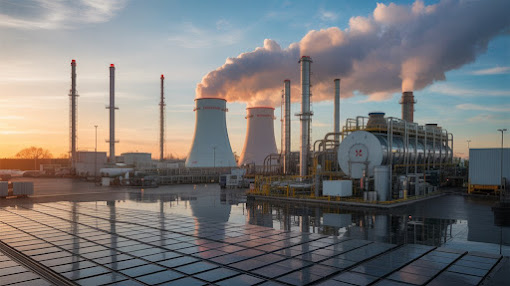CO Emissions in Gas Turbines | #COModeling #FlameletModels #GasTurbine #CleanCombustion #ChemicalKinetics #PremixedFlames
Accurate prediction of carbon monoxide (CO) emissions in gas turbine combustion is crucial for meeting stringent environmental regulations, especially under low-load, low-temperature conditions where CO formation and oxidation are highly sensitive to local flame dynamics. This work presents a comprehensive evaluation of advanced flamelet-based modeling approaches for CO emissions in turbulent premixed methane/air flames, focusing on the impact of flame-wall interactions (FWI) and turbulent strain.
Introduction
Carbon monoxide (CO) emissions from gas turbines are a major concern, especially under lean and low-load operating conditions where incomplete combustion occurs due to reduced flame temperatures and shorter residence times. The formation and oxidation of CO are highly sensitive to local flame structure, turbulence, and interactions with cold combustor walls. Traditional reduced-order models often fail to capture these effects accurately, leading to errors in CO predictions.
Key Findings:
-
Strained flamelets effectively model CO formation in the early flame region by capturing turbulence-induced flame stretch.
-
Quenching manifolds (QFM) significantly improve CO prediction near walls by incorporating heat loss and quenching effects.
-
The CO transport equation enhances accuracy in the post-flame region, where oxidation occurs on longer time scales.
-
No single model is universally superior; a hybrid or region-specific approach is recommended to balance complexity and accuracy.
Keywords:
CO Emissions, Flamelet Modeling, Quenching Manifold, Turbulent Premixed Flames, Gas Turbine Combustion, Flame-Wall Interaction, Large Eddy Simulation (LES), Direct Numerical Simulation (DNS)
Potential Usage:
This content is ideal for:
-
A conference presentation abstract (e.g., AIAA, Combustion Symposium)
-
A research paper introduction/summary
-
A technical blog post or LinkedIn article targeted at combustion engineers or CFD researchers
Motivation and Challenges
Key challenges in CO prediction include:
-
Long chemical time scales for CO oxidation, especially downstream of the flame front.
-
Flame-wall interaction (FWI) that leads to local quenching and inhibits complete oxidation.
-
Turbulence-chemistry interaction, particularly at high Karlovitz numbers, which modifies flame structure and CO formation rates.
-
The need for computationally affordable models compatible with large-eddy simulations (LES) while preserving chemical accuracy.
Modeling Approach
Strained Flamelets
Strained flamelets extend traditional flamelet approaches by incorporating local flame stretch due to turbulence. These flamelets are computed at various strain rates and tabulated as functions of a progress variable and mixture fraction (or equivalence ratio). They enhance accuracy in regions of strong turbulence, particularly in the flame front where CO is formed.
Quenching Flamelet-Generated Manifolds (QFM)
QFM models are constructed using flamelets from head-on quenching (HOQ) scenarios, capturing the influence of heat loss to cold walls and partial flame extinction. A third manifold dimension is introduced to account for variations in enthalpy and wall heat flux, enabling better prediction of species like CO in near-wall regions.
CO Transport Equation
To overcome the limitations of tabulated chemistry in regions with long oxidation time scales, a CO-specific transport equation is coupled with the flamelet model. This allows the delayed oxidation process to be explicitly captured, especially downstream of the flame and near cold walls.
DNS Database for Model Evaluation
A direct numerical simulation (DNS) database was employed for a-priori evaluation of the proposed models. The domain includes:
-
Two premixed methane/air jet flames.
-
Enclosed by isothermal walls, inducing flame-wall interaction.
-
Recirculation zones that trap intermediate species like CO.
-
Operating conditions representative of gas turbine combustion (elevated pressure, high Reynolds and Karlovitz numbers).
The simulations are performed using the CIAO code with finite-rate chemistry and a 25-species skeletal methane mechanism.
Results and Discussion
-
CO Formation Stage (Upstream): The strained flamelet model accurately captures the rapid CO production in high-strain turbulent regions.
-
Post-Flame Region (Downstream): The CO transport model and QFM capture the delayed oxidation and wall-quenching effects more effectively than standard flamelet approaches.
-
Near-Wall Region: The QFM model shows significant improvement in CO prediction due to its treatment of enthalpy loss and quenching.
-
Filtered LES Analysis: When applied to LES-filtered fields, all models showed degradation, but the hybrid approach combining QFM, strained flamelets, and a CO transport equation retained the highest fidelity.
Conclusions
This work demonstrates that no single model can capture all CO-related phenomena in gas turbine-relevant combustion. However, a combined approach that includes:
-
Strained flamelets for turbulence effects,
-
Quenching manifolds (QFM) for flame-wall interaction,
-
And a transport equation for CO to resolve long oxidation delays,
…yields the most accurate predictions across the full domain. The findings support the development of more reliable and robust reduced-order models for use in LES of practical gas turbine combustors.
Future Work
Future directions include:
-
Application of the hybrid model in full-scale LES of industrial combustors.
-
Extension of the QFM approach to side-wall quenching (SWQ) scenarios.
-
Incorporation of radiation heat loss and multi-fuel capabilities.
International Phenomenological Research Awards




Comments
Post a Comment